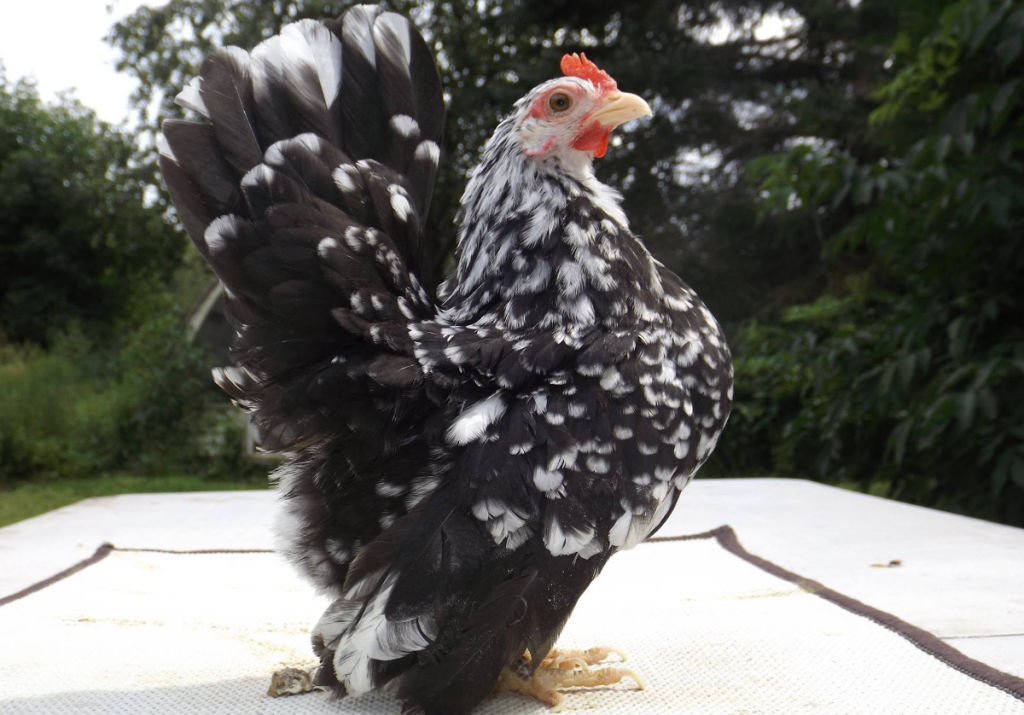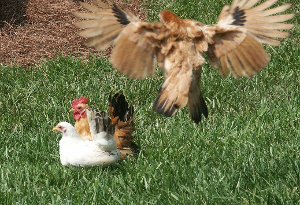Serama bantams as pets.

Serama as pets:
In its home country of Malaysia the Serama outnumbers the cat and the dog as the most popular pet. They are often kept in the house due to their small size. Here in the UK the Serama's popularity as a pet is increasing though most are housed outdoors for hygiene reasons.
The Serama are identified by their vertical tail feathers, near-vertical wings, full breast, and Short legs. The Serama is comparatively new to the rest of the chicken keeping world being imported from Malaysia in 2000.
As of now, they remain an uncompleted work, and need much more work before they’ll be accepted .The biggest difference between A Serama and a regular chicken is both their little size and friendly personality.
The big advantage of these surplus birds that might not be much good for the show bench is they make excellent pets that are easy to keep because of their size and still lay eggs.
Caring for your Serama bantam:
Serama are actually very easy to care for.
The main difference between a Serama and a regular chicken is their size. Serama are very small so they need to be kept safe from predators, and also kept warm. I highly recommend letting your birds range in a confined area during the day, because I have found that this boosts fertility and general health tremendously. The birds love it, and are more contented, and better producers.
Below: Serama bantams can fly but not well.

Just make sure that when the weather is bad outside, you have a suitable place for them to go into. This can be a coop, a shed, or a partition of a building. Make sure that inside is warn, dry and free from parasites.
I advise using sand or wood shavings, as the birds do not ingest them, they are easy to clean, and they last a long time. The Serama is a very personable little bird, and thrives on human interaction. Make sure you spend some time with your birds, they and you will both love it.
Serama eat regular chicken feed, but I have found that they do better on crumbles or mash, than on pellets. They should also have free choice grit and oyster shell. Treats may be fed in the form of grapes, bread, corn, and meal worms for example.
That the Serama does not breed true means two things.
1. Any pair of Serama, can produce any of over 2500 documented colour varieties. Breeding a black bird to a black bird does not mean you will get black offspring. This is yet another reason why the Serama is so fun, because you never know what you will get!
2. Serama also do not breed true to size, meaning that if you take a Class A bird and breed it to another Class A bird, you could get birds that are either Class A, B, or C.
Raising Serama:
Although Serama are not your common everyday chicken, they are no harder to raise then any other quality bantam. The Serama makes a great pet as it takes up little space, makes less noise than larger chickens and is easy to handle due to it's small size and friendly nature.
Whilst some will advise against Serama being children's pets, I believe that the Serama makes an excellent child's pet. The Serama, contrary to popular belief is a generally hardy little breed.
Mine are hatched alongside Belgian & Dutch bantams which can be almost double the size of Serama chicks, they are reared together & the Serama are almost always the dominant birds in the pen despite the sometimes huge size differences.
Are Serama roosters aggressive?
Neither Serama hens or roosters are aggressive.
My Serama are brought up with my children aged 3 and 2 and are handled by the children from just days of age. This, in my opinion builds their strong and confident characters, which are a must for this little breed. I give no special treatment to my Serama and they are reared & kept in the exact same way as I would keep any other breed of chicken.
Serama are minute, so they have to be kept safe from predators, and also be kept toasty warm. If they have outside access, they will need an acceptable place to use for shelter. This could be a coop, a shed, or a partition of a building.
Are Serama bantams good pets?
The Serama is a particularly charming tiny Bird, and prospers with human interaction.
The Serama makes a gorgeous pet and companion, both inside and outdoors. Their tiny size needs small spaces and a pair or trio can be caged in a four foot square enclosure. Serama should be let out of their cages when they are safe from predators like dog's, cats and bird's of prey.
Serama sometimes raise a racket when an unfamiliar animal or object is sighted and are safe all alone so long as there are people within reach who can recognise when they are under threat.
They make great companions whilst gardening and enjoying the mornings / evenings on the porch. Their regal appearance and natural beauty adds to the splendour of any garden or home.
Male Serama must be caged individually as young as feasible to stop disfigurement and confidence loss from fights. Adult roosters must not ever be penned together as the dominant rooster may kill or disfigure the weaker rooster. Show quality females should, similarly, be individually penned.
Show coaching should begin as quickly as the confidence of Serama chicks starts to appear. This will be seen in the way the chicks carries itself and the bright red in the face and comb. Chicks also have a tendency to chirp incessantly when their confidence is high.
Coaching is carried out by catching and holding the chicks with both hands and putting the chicks on a table. It's likely that new trainee will squat and refuse to move for the 1st few times. Leave the trainee so long as required till they stand and move around.
After they stand, stroking gently on the throat beneath the wattles of the chick inspires the chick to pose with it's head held regally high and vertical to the ground. When they get use to the routines, posing with a regal position becomes natural for most Serama.
When children are handling Serama they must always be supervised as a rough child may injure them. Short periods of handling are great for Serama as they do very much enjoy being the centre of attention.
Children will learn compassion through handling Serama gently, they will also learn responsibility through keeping a pet as they will be responsible for helping with the upkeep, by helping to clean out, feed & water the birds.
The Serama youngster is often cheeky and inquisitive and will often perch on your hand or as in this picture of my son and a young grower pullet, she has made herself at home on his foot!
